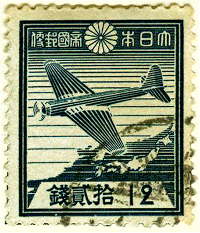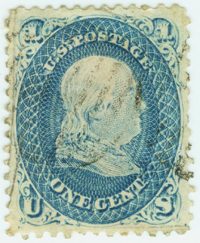
Discussion - Member to Member Sales - Research Center

Discussion - Member to Member Sales - Research Center

Regards,
Ralph

1 Member
likes this post.
Login to Like.
Interesting article, but I noticed that it does not address the fact that the choice of stamp colour was not free: UPU rules stipulated that a stamp for international standard printed matter had to be green, for a postcard red and a letter had to be blue.
These were the most important rates and therefore also the most used colours. There were others as well: brown that came somewhere between red and blue, but I have not been able to find a reference to what such a stamp was meant for.
By using these colours, postal workers were able to see if a letter from abroad was stamped adequately without having to know all the rates used in foreign countries.
To make a long story short: the UPU colour coding system, which has been in use in the US until the 1950s, explains why there are so few yellow stamps.

Login to Like
this post
I really enjoyed the article and didn't know yellow was the least used color. I thought it might be orange and that's why I buy a few orange stamps just for the color. One dealer at a small show was intrigued by that as I went through his foreign stock looking for orange or close enough to orange. But the topic of color was a great idea for a story.Thanks for the research on that!

Login to Like
this post
Steve.
Glad you liked the article. Yes, color is a fascinating philatelic topic. As for the color orange, U.S. stamps have indeed used orange as a primary color quite a bit, definitely more than yellow.
My research shows the following U.S. stamps that Scott lists as "orange":
• 1857-1861 30¢ Franklin (Scott 38)
• 1861-1867 30¢ Franklin (Scott 71, 81, 100)
• 1870 15¢ Webster (Scott 141, 152, 174, 189 and 199)
• 1875 30¢ Franklin (Scott 110)
• 1890 90¢ Perry (Scott 229)
• 1894 50¢ Jefferson (Scott 260)
• 1895 50¢ Jefferson (Scott 275)
• 1902-1903 50¢ Jefferson (Scott 310)
• 1908 Series 6¢ Washington (Scott 336, 362, 379, 429, 468 and 506)
• 1913 10¢ Panama-Pacific Exposition (Scott 400A)
• 1914-1915 10¢ Panama-Pacific Exposition (Scott 404)
• 1922-1925 6¢ Garfield (Scott 558, 587, 638, 664 “Kans.†overprint, 675 “Nebr.†overprint and 723)
• 1922-1929 10¢ James Monroe (Scott 562, 591, 603, 642) and Canal Zone issues (Scott C.Z. 75, 87, 99, and 104)
• 1897-1903 Trans-Mississippi Exposition 4¢ Buffalo (Scott 287)
• 1932 6¢ Washington (Scott 711)
• 1938 ½¢ Franklin (Scott 803) and the Canal Zone overprint (Scott CZ118)
• 1918 6¢ Curtiss Jenny (Scott C1)
• 1934 6¢ Winged Globe (Scott C19)
• 1941 50¢ Airplane (Scott C31)
• 1893 10¢ Running Messenger Special Delivery (Scott E3)
• 1925 15¢ Motorcycle Messenger Special Delivery (Scott E13)
• 1931 15¢ Motorcycle Messenger Special Delivery (Scott E16)
And, I believe as I said in my article, research into "yellow-orange" and "orange-yellow" stamps can be quite rewarding and fun.
Enjoy!

1 Member
likes this post.
Login to Like.

Whether puzzling over shade varieties or simply enjoying our stamps, color is a significant factor in philately. SOR member Steve Swain has just published another article for the website: Yellow - A Significant but Elusive U.S. Stamp Color. As the title implies the article explores the limited use of the color yellow on single color United States stamps. It’s a very interesting read, and as we’ve come to expect from Steve, a very artfully assembled piece. Thanks Steve and keep up the good work.
Regards,
Ralph

1 Member
likes this post.
Login to Like.

Auctions - Approvals
re: New Article: Yellow - A Significant, but Elusive, U.S. Stamp Color
Interesting article, but I noticed that it does not address the fact that the choice of stamp colour was not free: UPU rules stipulated that a stamp for international standard printed matter had to be green, for a postcard red and a letter had to be blue.
These were the most important rates and therefore also the most used colours. There were others as well: brown that came somewhere between red and blue, but I have not been able to find a reference to what such a stamp was meant for.
By using these colours, postal workers were able to see if a letter from abroad was stamped adequately without having to know all the rates used in foreign countries.
To make a long story short: the UPU colour coding system, which has been in use in the US until the 1950s, explains why there are so few yellow stamps.

Login to Like
this post
07:45:19pm
re: New Article: Yellow - A Significant, but Elusive, U.S. Stamp Color
I really enjoyed the article and didn't know yellow was the least used color. I thought it might be orange and that's why I buy a few orange stamps just for the color. One dealer at a small show was intrigued by that as I went through his foreign stock looking for orange or close enough to orange. But the topic of color was a great idea for a story.Thanks for the research on that!

Login to Like
this post

re: New Article: Yellow - A Significant, but Elusive, U.S. Stamp Color
Steve.
Glad you liked the article. Yes, color is a fascinating philatelic topic. As for the color orange, U.S. stamps have indeed used orange as a primary color quite a bit, definitely more than yellow.
My research shows the following U.S. stamps that Scott lists as "orange":
• 1857-1861 30¢ Franklin (Scott 38)
• 1861-1867 30¢ Franklin (Scott 71, 81, 100)
• 1870 15¢ Webster (Scott 141, 152, 174, 189 and 199)
• 1875 30¢ Franklin (Scott 110)
• 1890 90¢ Perry (Scott 229)
• 1894 50¢ Jefferson (Scott 260)
• 1895 50¢ Jefferson (Scott 275)
• 1902-1903 50¢ Jefferson (Scott 310)
• 1908 Series 6¢ Washington (Scott 336, 362, 379, 429, 468 and 506)
• 1913 10¢ Panama-Pacific Exposition (Scott 400A)
• 1914-1915 10¢ Panama-Pacific Exposition (Scott 404)
• 1922-1925 6¢ Garfield (Scott 558, 587, 638, 664 “Kans.†overprint, 675 “Nebr.†overprint and 723)
• 1922-1929 10¢ James Monroe (Scott 562, 591, 603, 642) and Canal Zone issues (Scott C.Z. 75, 87, 99, and 104)
• 1897-1903 Trans-Mississippi Exposition 4¢ Buffalo (Scott 287)
• 1932 6¢ Washington (Scott 711)
• 1938 ½¢ Franklin (Scott 803) and the Canal Zone overprint (Scott CZ118)
• 1918 6¢ Curtiss Jenny (Scott C1)
• 1934 6¢ Winged Globe (Scott C19)
• 1941 50¢ Airplane (Scott C31)
• 1893 10¢ Running Messenger Special Delivery (Scott E3)
• 1925 15¢ Motorcycle Messenger Special Delivery (Scott E13)
• 1931 15¢ Motorcycle Messenger Special Delivery (Scott E16)
And, I believe as I said in my article, research into "yellow-orange" and "orange-yellow" stamps can be quite rewarding and fun.
Enjoy!

1 Member
likes this post.
Login to Like.

